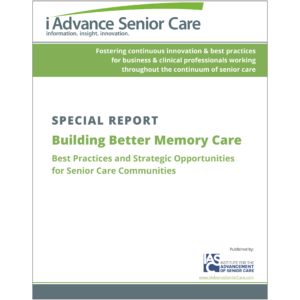Disaster planning for elderly ‘woefully inadequate’
While much of Washington’s attention is focused on healthcare reform and how to pay for it, the feds have been told that existing resources and plans to care for the elderly during a disaster or other emergency are woefully inadequate and need to be addressed as well.
During a Senate Special Committee on Aging hearing in late June, LuMarie Polivka-West, senior vice president of the Florida Health Care Association (FHCA), said current national emergency plans do not address the special needs of the elderly population, including residents of nursing homes or assisted living facilities, in the event of a disaster, such as a flood or a hurricane.
Polivka-West pointed out that when Hurricane Katrina hit in 2005, only 15% of the New Orleans population was age 60 or older, but 74% of hurricane-related deaths were in that age group.
“These elderly citizens did not all die from the disastrous flooding,” she said. “Many died from the heat, when lack of electricity to long-term care facilities caused dehydration, spoiled medications, or otherwise negatively impacted critical medical treatments and care services. Some individuals were evacuated without their lifesaving medications. Due to a lack of coordination, some very ill, aged individuals were left on tarmacs without identification, separated from medical records and medications, and transported to other states.”
Since then there have been some improvements, Polivka-West said, contending that much more needs to be done.
At the first Long Term Care Hurricane Summit, she recalled, it was pointed out that long-term care providers were not incorporated into existing emergency response systems and plans at the federal, state, or local levels. “Long-term care was an afterthought,” she said. “Vulnerable, medically frail and disabled patients and residents were largely dependent upon the limited capability of each individual provider and their individual disaster plan, which was not coordinated with governmental emergency efforts.”
To resolve that problem, 2006 and 2007 Hurricane Summit participants recommended that the National Response Plan (NRP) incorporate long-term care facilities in its unified, all-discipline, all-hazards approach to disaster planning, response, and recovery.
In January 2008, the Department of Homeland Security issued the National Response Framework (NRF) to replace the NRP. While it mentions “individuals with special needs, including those with service animals,” it does little else, according to Polivka-West. “Those individuals residing in long-term care facilities remain undifferentiated at the national level in disaster planning to this day,” she declared.
Polivka-West pointed out that the American Health Care Association (AHCA), National Center for Assisted Living (NCAL), and the FHCA believe that the NRF and national guidelines “should more fully address the very disparate special needs population and should specifically identify fragile individuals who live in long-term care settings.”
Identifying long-term care in national preparation and response policy is important to both ensure that federal assets are directed to long-term care settings as needed and to ensure that state and local governments receive clear guidance on the importance of responding to the needs of these individuals during times of disaster, she said.
Pointing out that planning for every scenario is impossible, Polivka-West said the disaster mitigation and response plans developed under a John A. Hartford Foundation grant for nursing homes and assisted living facilities are comprehensive and provide a sound emergency response template for use by the long-term care profession.
Polivka-West offered six specific recommendations:
The National Disaster Medical System should be reconfigured to support the evacuation and care of nursing home patients/residents, assisted living residents, and people residing in residential care facilities for the elderly and developmentally disabled.
The development of interoperable electronic health records must be expedited.
Federal law that prevents for-profit nursing homes that provide care to the publicly funded Medicare and Medicaid residents from receiving federal financial aid during and after disasters should be changed. The Nursing Home Emergency Assistance Act of 2009, now before Congress, would permit all long-term care providers-including for-profit facilities-to obtain disaster relief funding.
Emergency communications must be improved with local healthcare providers and facilities, local police, ambulance services, and others involved in search and rescue, having satellite phone capacity, or broadband satellite Internet capacity, powered by generators.
Federal agencies need to work together to identify requirements for long-term care facilities in their all-hazard approaches to disaster preparedness.
New protocols are necessary to improve communications and coordination between all providers and the local, state, and federal governments with the NRF as the guide for plan development at all levels.
“While the long-term care community prides itself on its preparatory work and planning for emergencies,” Polivka-West said, “the long-term care community alone cannot prepare effectively for disaster; we must be part of the larger unified national response.”
Meanwhile, as the healthcare reform debate continued with the goal of sending a bill to President Obama by October, the American Association of Homes and Services for the Aging (AAHSA), and AHCA/NCAL were desperately trying to convince Congress not to impose Medicare cuts in reimbursement levels.
In his healthcare reform proposal, Obama called for a freeze on Medicare payment rates for skilled nursing facilities (SNFs) in 2010 in addition to the home healthcare payment freeze included in his earlier budget proposal.
While the Medicare Payment Advisory Commission (MedPAC) recommended no payment update for SNFs next year, it noted that a freeze would have a disproportionately severe impact on facilities serving those with complex care needs, often the not-for-profit facilities whose Medicare margins are “small to nonexistent.”
“The denial of the payment update, combined with a pending recalibration of Medicare payment rates, could result in Medicare payment cuts of 3.3% or more for SNFs, depending on their case mix and geographic location,” AAHSA said in an Action Alert to its members.
In early June, nearly 400 members of AHCA/NCAL visited Capitol Hill to lobby lawmakers on federal long-term care issues. According to AHCA/NCAL President and CEO Bruce Yarwood, one of the most pressing concerns is the proposed Medicare regulation that would cut Medicare funding by $1.05 billion in fiscal year 2010 and $18 billion over 10 years.
According to Alan G. Rosenbloom, president of the Alliance for Quality Nursing Home Care, that regulation could cut 30,000 key health jobs and stifle delivery system reforms already in place.
To send your comments to the editor, e-mail mhrehocik@iadvanceseniorcare.com.

Robert Gatty has more than 40 years of experience in journalism, politics and business communications and is the founder and president of G-Net Strategic Communications based in Myrtle Beach, South Carolina. He can be reached at bob@gattyedits.com.
Related Articles
Topics: Articles , Facility management , Operations











